Schrebera alata
Schrebera alata (Hochst.)Welw.
Family: Oleaceae
Common names: wild jasmine, wing-leafed wooden pear, (Eng.); wildejasmyn, houtpeer (Afr.); mulungwi (Venda); umGwenye-hlangula (Xhosa); umGwenya-hlungulu, umSishane-wehlanze, umTshwatshwala, loziphungwane (Zulu)
SA Tree No: 612
Introduction
Wild jasmine anoints your garden with a pleasant, sweet-scented fragrance and glorifies it with white to dark pinkish red flowers during the summer season. The flowers attract a parade of bees, hawkmoths and dusk-flying butterflies.
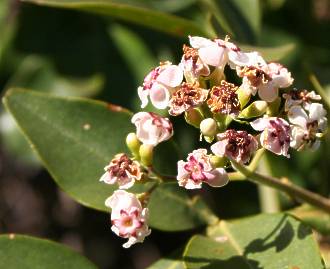
Description
Description
Schrebera alata is a quick-growing evergreen tree or shrub, 4-15 m high, with a greyish or light brown bark. The leaves are opposite and pinnately compound with few leaflet pairs and a single terminal one. The petiole and rachis are narrowly winged. The leaves are shiny dark green above, paler beneath and smooth or velvety when young. The flowers are trumpet-shaped and white to pink, with reddish brown hairs near the mouth of the corolla tube. They are sweet-scented (the fragrance is stronger in the evening), and arranged in terminal clusters up to 110 mm long. Flowering time is September - May.
The fruits are pear-shaped and shiny green, turning brown in maturity and becoming woody. They split into two halves when ripe and contain about 8 papery, winged seeds. The seeds are dispersed by wind. Fruiting time is March - July.
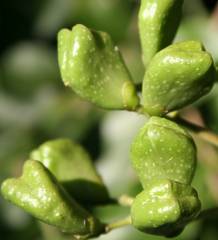
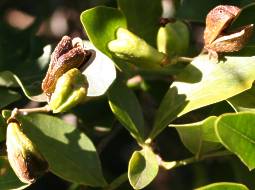
Conservation Status
Status
According to Golding (2002), Schrebera alata is not listed as threatened or endangered.
Distribution and habitat
Distribution description
This sweet-scented, lovely tree occurs on the margins of forest or bushveld of Limpopo, Gauteng, Mpumalanga and KwaZulu-Natal. It is also found in Swaziland, through southern Mozambique, and north to tropical Africa.

Derivation of name and historical aspects
History
The genus Schrebera was named after J.D.C. von Schreber (1739-1810), a German botanist; the species name alata refers to the winged leaf rachis.
Ecology
Ecology
The wild jasmine's scented flowers attract bees to the garden, while hawkmoths and dusk-flying skipper butterflies are also often seen sipping nectar from the tubular flowers.
Schrebera alata is related to S. trichoclada, which has white to yellow flowers and simple leaves. When not in flower, the wild jasmine's leaves can easily be mistaken for those of Loxostylis alata (tarwood), which has more leaflets to each leaf. It can also be confused with Ekebergia pterophylla, which has alternate leaves.
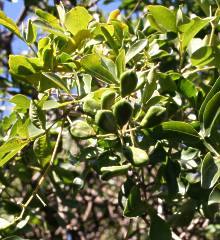
Uses
Use
It is mainly used as a decorative and ornamental garden plant.
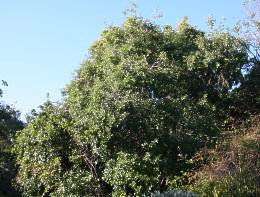
Growing Schrebera alata
Grow
It is very easy to grow Schrebera alata plants in a garden. Sow seeds in early spring and they will germinate in about four weeks' time. Mix the soil with compost or sieved leaf litter; give plenty of water and maintain a warm temperature. Transfer young plants to individual pots for about a year, before planting them into the ground, and water them regularly. These trees prefer warm environments and young plants must be sheltered to prevent frost damage.
References
- Coates Palgrave, M. 2002. Keith Coates Palgrave Trees of southern Africa, edn 3: 913. Struik, Cape Town.
- Eliovson, S. 1973. South African wild flowers for the garden. The all-in-one guide: how to identify and grow shrubs, trees, perennials, annuals, bulbs and succulents, edn 5: 268. Macmillan, Johannesburg.
- Germishuizen, G. & Fabian, A. 1997. Wildflowers of northern South Africa: 296. Fernwood Press, Cape Town.
- Germishuizen, G. & Meyer, N.L. (eds). 2003. Plants of southern Africa: an annotated checklist. Strelitzia 14: 753. National Botanical Institute, Pretoria.
- Germishuizen, G., Meyer, N.L., Steenkamp, Y. & Keith, M. (eds). 2006. A checklist of South African plants. Southern African Botanical Diversity Network Report No. 41: 673. SABONET, Pretoria.
- Golding, J.S. (ed.) 2002. Southern African plant Red Data lists. Southern African Botanical Diversity Network Report No. 14. SABONET, Pretoria.
- Joffe, P. 1993. Gardener's guide to South African plants: 74, 75. Tafelberg, Cape Town.
- Pooley, E. 1993. The complete field guide to the trees of Natal, Zululand and Transkei: 408, 409. Natal Flora Publications Trust, Durban.
- Retief, E. & Herman, P.P.J. 1997. Plants of the northern provinces of South Africa: keys and diagnostic characters. Strelitzia 6: 545. National Botanical Institute, Pretoria.
- Schmidt, E., Lötter, M. & McCleland, W. 2002. Trees and shrubs of Mpumalanga and Kruger National Park: 536, 537. Jacana, Johannesburg.
- Van Wyk, A.E. (Braam) & Van Wyk, P. 1997. Field guide to trees of southern Africa: 418, 419. Struik, Cape Town.
Credits
Mashiane Mothogoane
National Herbarium, Pretoria
January 2010
Plant Attributes:
Plant Type: Shrub, Tree
SA Distribution: Gauteng, KwaZulu-Natal, Limpopo, Mpumalanga
Soil type: Loam
Flowering season: Late Summer
PH:
Flower colour: Red, White, Pink
Aspect: Full Sun
Gardening skill: Easy
Special Features:
Horticultural zones









Rate this article
Article well written and informative
Rate this plant
Is this an interesting plant?
Login to add your Comment
Back to topNot registered yet? Click here to register.